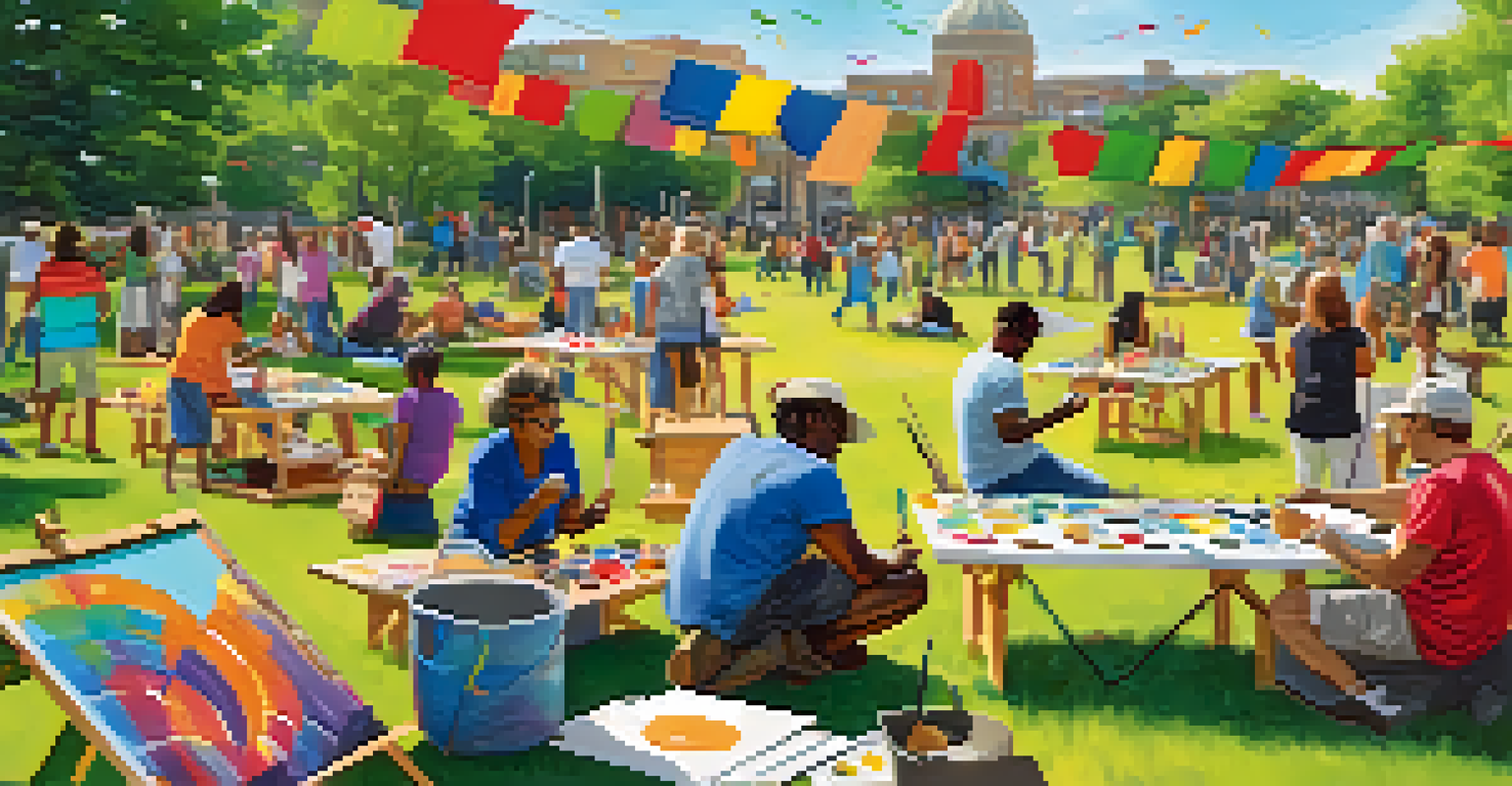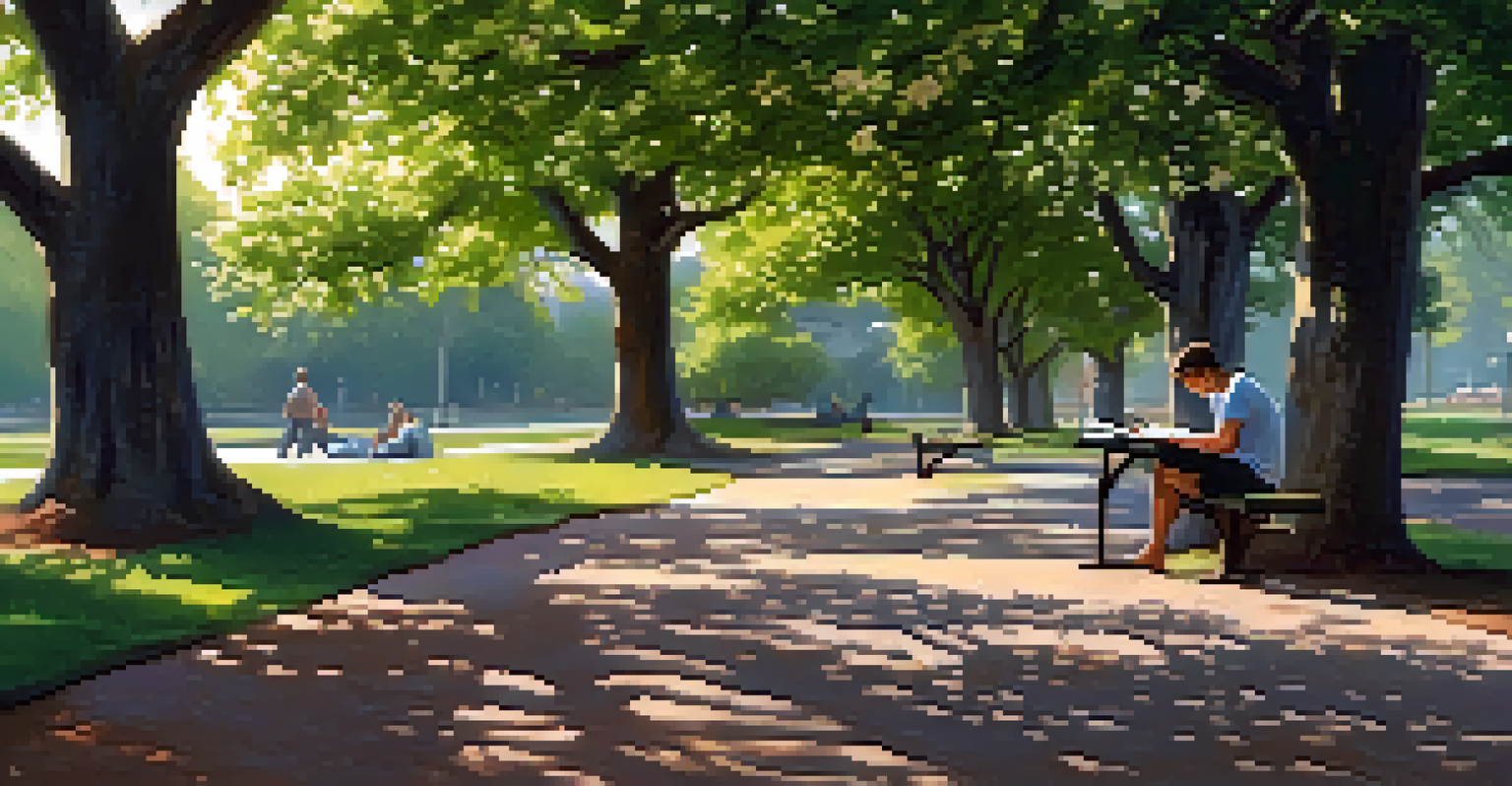Art as a Communication Tool for Mental Health Challenges

Understanding Art as a Form of Communication
Art has long been a means of communication, transcending language barriers and cultural differences. It allows individuals to express emotions and thoughts that may be difficult to articulate verbally. This is particularly valuable for those facing mental health challenges, as they often struggle to convey their feelings and experiences.
Art enables us to find ourselves and lose ourselves at the same time.
Through various forms of art—be it painting, music, or dance—people can channel their inner turmoil into something tangible. This act of creation not only serves as an outlet for their emotions but also fosters a sense of connection with others. Art can tell a story that words sometimes cannot, bridging the gap between isolation and understanding.
Moreover, engaging with art can provide a safe space for individuals to explore their feelings. Whether creating or observing, the process invites reflection and introspection, often leading to greater self-awareness and healing.
The Therapeutic Benefits of Artistic Expression
Art therapy has emerged as a recognized practice within mental health treatment. It combines therapeutic techniques with artistic processes to help individuals express themselves and work through emotional challenges. This form of therapy can be particularly effective for those who find it hard to communicate their thoughts through traditional talk therapy.

Creating art allows individuals to externalize their feelings, providing a visual representation of their internal struggles. For instance, someone dealing with anxiety might create chaotic, swirling patterns that reflect their mental state. This not only helps in identifying emotions but also in processing them in a constructive manner.
Art as Emotional Expression
Art enables individuals to express complex emotions and thoughts that may be difficult to convey verbally.
Additionally, the act of creating art can be calming and meditative. It encourages mindfulness, pulling individuals into the present moment and away from stressful thoughts. This therapeutic aspect can alleviate symptoms of anxiety and depression, promoting overall mental well-being.
Art as a Tool for Self-Discovery
Engaging with art can lead to profound self-discovery, enabling individuals to explore hidden aspects of themselves. When creating art, people often tap into subconscious thoughts and feelings that can reveal their true selves. This journey of exploration can be both enlightening and empowering.
Every artist dips his brush in his own soul, and paints his own nature into his pictures.
For example, a person might start painting as a hobby and gradually realize that they are expressing feelings of sadness or anger they were previously unaware of. This revelation can motivate them to seek further understanding and healing, fostering personal growth. Art acts as a mirror, reflecting emotions that may be buried deep within.
Through this process, individuals can develop a deeper understanding of their mental health challenges. It can also inspire them to make positive changes in their lives, as they gain clarity about what they want and need for their well-being.
Connecting with Others Through Art
Art can serve as a powerful connector, bringing people together who share similar experiences and struggles. Community art projects, workshops, and exhibitions can foster a sense of belonging, which is crucial for those dealing with mental health issues. These shared experiences can help combat feelings of isolation and loneliness.
When individuals come together to create or appreciate art, they often find common ground. This connection can lead to meaningful conversations, support networks, and friendships that promote healing. Knowing others understand their struggles can be incredibly validating and comforting.
Therapeutic Benefits of Art
Art therapy combines creative processes with therapeutic techniques to help individuals work through emotional challenges.
Additionally, sharing one’s artwork can be an act of vulnerability that strengthens social bonds. It invites dialogue and empathy, allowing others to see the world through the artist's eyes. This shared understanding can pave the way for deeper connections and support.
The Role of Art in Mental Health Awareness
Art has the power to raise awareness about mental health challenges, breaking down stigma and encouraging open conversations. Artists often use their platforms to highlight their struggles, prompting audiences to reflect on their perceptions of mental health. This visibility fosters understanding and empathy in society.
Artistic campaigns, murals, and exhibitions can spark dialogue around mental health issues, creating opportunities for education and support. When people see art that resonates with their experiences, it can validate their feelings and inspire them to seek help. This shift in perception is essential for reducing stigma and promoting acceptance.
Moreover, public art projects can engage communities in discussions about mental health, creating a collective movement towards awareness. By showcasing diverse experiences through art, society can recognize the importance of mental health and the need for compassionate support systems.
Creative Outlets Beyond Traditional Art Forms
While traditional art forms like painting and sculpture are widely recognized, there are numerous creative outlets that can support mental health. Activities such as writing, photography, and even gardening can provide similar benefits. Each of these pursuits allows for emotional expression and personal reflection.
For instance, journaling can be incredibly therapeutic, offering a private space to explore thoughts and emotions. Writing poetry or stories can also serve as a way to process experiences and find meaning in them. These creative expressions can be just as impactful as visual arts in promoting mental well-being.
Community Connection Through Art
Engaging in art fosters connections among individuals, creating a sense of belonging and support for those facing mental health issues.
Additionally, engaging in creative activities fosters a sense of accomplishment and boosts self-esteem. Whether it's completing a scrapbook or capturing a beautiful photograph, these small victories can enhance overall mental health and provide a solid foundation for personal growth.
Incorporating Art into Daily Life for Mental Health
Integrating art into daily routines can significantly enhance mental health and emotional resilience. Simple activities like doodling, coloring, or playing an instrument can be powerful ways to express oneself and relieve stress. These creative practices encourage mindfulness and can serve as a break from daily challenges.
Setting aside time for artistic pursuits can establish a healthy outlet for emotions. Whether it’s a weekly painting session or a daily journaling practice, consistency in creativity can foster emotional stability. Over time, these habits can become essential coping strategies for managing mental health challenges.

Moreover, even appreciating art—through visits to galleries, listening to music, or watching performances—can uplift spirits and inspire positivity. Surrounding oneself with creativity can create an environment that nurtures mental well-being and encourages a more fulfilling life.